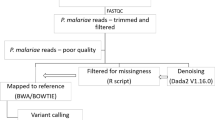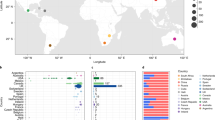Abstract
Human babesiosis caused by Babesia microti is an emerging tick-borne zoonosis of increasing importance due to its rising incidence and expanding geographic range1. Infection with this organism, an intraerythrocytic parasite of the phylum Apicomplexa, causes a febrile syndrome similar to malaria2. Relapsing disease is common among immunocompromised and asplenic individuals3,4 and drug resistance has recently been reported5. To investigate the origin and genetic diversity of this parasite, we sequenced the complete genomes of 42 B. microti samples from around the world, including deep coverage of clinical infections at endemic sites in the continental USA. Samples from the continental USA segregate into a Northeast lineage and a Midwest lineage, with subsequent divergence of subpopulations along geographic lines. We identify parasite variants that associate with relapsing disease, including amino acid substitutions in the atovaquone-binding regions of cytochrome b (cytb) and the azithromycin-binding region of ribosomal protein subunit L4 (rpl4). Our results shed light on the origin, diversity and evolution of B. microti, suggest possible mechanisms for clinical relapse, and create the foundation for further research on this emerging pathogen.
This is a preview of subscription content, access via your institution
Access options
Subscribe to this journal
Receive 12 digital issues and online access to articles
$119.00 per year
only $9.92 per issue
Buy this article
- Purchase on Springer Link
- Instant access to full article PDF
Prices may be subject to local taxes which are calculated during checkout




Similar content being viewed by others
References
Vannier, E. & Krause, P. J. Human babesiosis. N. Engl. J. Med. 366, 2397–2407 (2012).
Ruebush, T. K. & Spielman, A. Human babesiosis in the United States. Ann. Intern. Med. 88, 263–263 (1978).
Krause, P. J. et al. Persistent and relapsing babesiosis in immunocompromised patients. Clin. Infect. Dis. 46, 370–376 (2008).
Vyas, J. M., Telford, S. R. & Robbins, G. K. Treatment of refractory Babesia microti infection with atovaquone–proguanil in an HIV-infected patient: case report. Clin. Infect. Dis. 45, 1588–1590 (2007).
Wormser, G. P. et al. Emergence of resistance to azithromycin–atovaquone in immunocompromised patients with Babesia microti infection. Clin. Infect. Dis. 50, 381–386 (2010).
Telford, S. R., III . Babesial infections in humans and wildlife. Parasitic Protozoa 5, 1–47 (1993).
Herwaldt, B. L. et al. Transfusion-associated babesiosis in the United States: a description of cases. Ann. Intern. Med. 155, 509–519 (2011).
Yager, P. H., Luginbuhl, L. M. & Dekker, J. P. Case 6-2014. N. Engl. J. Med. 370, 753–762 (2014).
Clark, I. A. & Jacobson, L. S. Do babesiosis and malaria share a common disease process. Ann. Trop. Med. Parasitol. 92, 483–488 (1998).
Hatcher, J. C., Greenberg, P. D., Antique, J. & Jimenez-Lucho, V. E. Severe babesiosis in Long Island: review of 34 cases and their complications. Clin. Infect. Dis. 32, 1117–1125 (2001).
Meldrum, S. C., Birkhead, G. S., White, D. J., Benach, J. L. & Morse, D. L. Human babesiosis in New York state: an epidemiological description of 136 cases. Clin. Infect. Dis. 15, 1019–1023 (1992).
Menis, M. et al. Babesiosis occurrence among the elderly in the United States, as recorded in large Medicare databases during 2006–2013. PLoS ONE 10, e0140332 (2015).
Hildebrandt, A. et al. First confirmed autochthonous case of human Babesia microti infection in Europe. Eur. J. Clin. Microbiol. Infect. Dis. 26, 595–601 (2007).
Wei, Q. et al. Human babesiosis in Japan: isolation of Babesia microti-like parasites from an asymptomatic transfusion donor and from a rodent from an area where babesiosis is endemic. J. Clin. Microbiol. 39, 2178–2183 (2001).
Senanayake, S. N. et al. First report of human babesiosis in Australia. Med. J. Aust. 196, 350–352 (2012).
Western, K. A., Benson, G. D., Gleason, N. N., Healy, G. R. & Schultz, M. G. Babesiosis in a Massachusetts resident. N. Engl. J. Med. 283, 854–856 (1970).
Centers for Disease Control and Prevention (CDC). Babesiosis surveillance—18 states, 2011. Morb. Mortal. Wkly Rep. 61, 505–509 (2012).
Krause, P. J. et al. Increasing health burden of human babesiosis in endemic sites. Am. J. Trop. Med. Hyg. 68, 431–436 (2003).
Stafford, K. C. III et al. Expansion of zoonotic babesiosis and reported human cases, Connecticut, 2001–2010. J. Med. Entomol. 51, 245–252 (2014).
Goethert, H. K. & Telford, S. R. Not ‘out of Nantucket’: Babesia microti in southern New England comprises at least two major populations. Parasites Vectors 7, 546 (2014).
Drummond, A. J., Ho, S. Y. W., Phillips, M. J. & Rambaut, A. Relaxed phylogenetics and dating with confidence. PLoS Biol. 4, e88 (2006).
Homer, M. J. et al. A polymorphic multigene family encoding an immunodominant protein from Babesia microti. J. Clin. Microbiol. 38, 362–368 (2000).
Srivastava, I. K., Morrisey, J. M., Darrouzet, E., Daldal, F. & Vaidya, A. B. Resistance mutations reveal the atovaquone-binding domain of cytochrome b in malaria parasites. Mol. Microbiol. 33, 704–711 (1999).
Korsinczky, M. et al. Mutations in Plasmodium falciparum cytochrome b that are associated with atovaquone resistance are located at a putative drug-binding site. Antimicrob. Agents Chemother. 44, 2100–2108 (2000).
Matsuu, A., Miyamoto, K., Ikadai, H., Okano, S. & Higuchi, S. Short report: cloning of the Babesia gibsoni cytochrome b gene and isolation of three single nucleotide polymorphisms from parasites present after atovaquone treatment. Am. J. Trop. Med. Hyg. 74, 593–597 (2006).
Sidhu, A. B. S. et al. In vitro efficacy, resistance selection, and structural modeling studies implicate the malarial parasite apicoplast as the target of azithromycin. J. Biol. Chem. 282, 2494–2504 (2007).
Malbruny, B. et al. Resistance to macrolides in clinical isolates of Streptococcus pyogenes due to ribosomal mutations. J. Antimicrob. Chemother. 49, 935–939 (2002).
Chittum, H. S. & Champney, W. S. Ribosomal protein gene sequence changes in erythromycin-resistant mutants of Escherichia coli. J. Bacteriol. 176, 6192–6198 (1994).
McFadden, D. C., Tomavo, S., Berry, E. A. & Boothroyd, J. C. Characterization of cytochrome b from Toxoplasma gondii and Q(o) domain mutations as a mechanism of atovaquone-resistance. Mol. Biochem. Parasitol. 108, 1–12 (2000).
Pihlajamäki, M. et al. Ribosomal mutations in Streptococcus pneumoniae clinical isolates. Antimicrob. Agents Chemother. 46, 654–658 (2002).
Li, H. & Durbin, R. Fast and accurate long-read alignment with Burrows–Wheeler transform. Bioinformatics 26, 589–595 (2010).
McKenna, A. et al. The genome analysis toolkit: a MapReduce framework for analyzing next-generation DNA sequencing data. Genome Res. 20, 1297–1303 (2010).
Pages, H., Aboyoun, P., Gentleman, R. & DebRoy, S. Biostrings (Bioconductor); http://bioconductor.fhcrc.org/packages/release/bioc/html/Biostrings.html
Gentleman, R. C. et al. Bioconductor: open software development for computational biology and bioinformatics. Genome Biol. 5, R80 (2004).
Pfeifer, B., Wittelsbürger, U., Onsins, S. E. R. & Lercher, M. J. PopGenome: an efficient Swiss army knife for population genomic analyses in R. Mol. Biol. Evol. 31, 1929–1936 (2014).
South, A. rworldmap: a new R package for mapping global data. The R Journal 3, 35–43 (2011).
Charif, D. & Lobry, J. R. in Structural Approaches to Sequence Evolution 207–232 (Springer, 2007).
Rutherford, K. et al. Artemis: sequence visualization and annotation. Bioinformatics 16, 944–945 (2000).
Edgar, R. C. MUSCLE: multiple sequence alignment with high accuracy and high throughput. Nucleic Acids Res. 32, 1792–1797 (2004).
Waterhouse, A. M., Procter, J. B., Martin, D. M. A., Clamp, M. & Barton, G. J. Jalview Version 2—a multiple sequence alignment editor and analysis workbench. Bioinformatics 25, 1189–1191 (2009).
Stamatakis, A. RAxML version 8: a tool for phylogenetic analysis and post-analysis of large phylogenies. Bioinformatics 30, 1312–1313 (2014).
Cornillot, E. et al. Sequencing of the smallest Apicomplexan genome from the human pathogen Babesia microti. Nucleic Acids Res. 40, 9102–9114 (2012).
Nei, M. & Gojobori, T. Simple methods for estimating the numbers of synonymous and nonsynonymous nucleotide substitutions. Mol. Biol. Evol. 3, 418–426 (1986).
Benjamini, Y. & Hochberg, Y. Controlling the false discovery rate: a practical and powerful approach to multiple testing. J. R. Stat. Soc. B 57, 289–300 (1995).
Birth, D., Kao, W.-C. & Hunte, C. Structural analysis of atovaquone-inhibited cytochrome bc1 complex reveals the molecular basis of antimalarial drug action. Nature Commun. 5, 4029 (2014).
Bulkley, D., Innis, C. A., Blaha, G. & Steitz, T. A. Revisiting the structures of several antibiotics bound to the bacterial ribosome. Proc. Natl Acad. Sci. USA 107, 17158–17163 (2010).
Simpson, J. T. et al. ABySS: a parallel assembler for short read sequence data. Genome Res. 19, 1117–1123 (2009).
Delcher, A. L. et al. Alignment of whole genomes. Nucleic Acids Res. 27, 2369–2376 (1999).
Melnikov, A. et al. Hybrid selection for sequencing pathogen genomes from clinical samples. Genome Biol. 12, R73 (2011).
Gnirke, A. et al. Solution hybrid selection with ultra-long oligonucleotides for massively parallel targeted sequencing. Nature Biotechnol. 27, 182–189 (2009).
Acknowledgements
The authors thank R. Tewhey, A. Piantadosi and J. Maguire for feedback and advice, and J. Robbins, J. Katz, J. Gelfand and T. Wieczorek for discussions and assistance with sample collection. The authors acknowledge members of the parasitology and haematology laboratories at Massachusetts General Hospital and Brigham and Women's Hospital for assistance with case identification. P.C.S. and this work are supported by the Broad Institute SPARC programme and the Bill and Melinda Gates Foundation and the Howard Hughes Medical Institute. This work was supported in part by an Infectious Disease Society of America Medical Scholars award, a MIT Division of Health Sciences and/MIT Division of Health Sciences and Technology Research Assistantship to J.E.L. and NIH MSTP grants T32GM007753 to J.E.L. and A.L. S.T. and H.K.G. are supported by NIH U01AI109656 and R41AI078631 and by grants from the Evelyn Lilly Lutz Foundation, the Dorothy Harrison Egan Foundation and the Bill and Melinda Gates Foundation. E.V. was supported by a grant from the National Research Fund for Tick-Borne Diseases.
Author information
Authors and Affiliations
Contributions
J.E.L. performed experiments, analysed data and wrote the paper. A.D.T. and H.G. performed experiments and analysed data. L.F. performed experiments. K.G.A. analysed data. S.F.S., A.L., S.T., E.R., J.A.B. and P.C.S. analysed data and wrote the paper. S.B., G.M., L.S. and D.M. contributed reagents/materials. E.V. and B.P. contributed materials/reagants and wrote the paper.
Corresponding author
Ethics declarations
Competing interests
The authors declare no competing financial interests.
Supplementary information
Supplementary information
Supplementary Methods, Supplementary Text, Supplementary Tables 1-8, Supplementary Figures 1-13 and Supplementary References. (PDF 2335 kb)
Supplementary Dataset 1
Draft assembly of the AW1 strain. (TXT 5806 kb)
Supplementary Dataset 2
Draft assembly of the CR400 strain. (TXT 6077 kb)
Supplementary Dataset 3
Draft assembly of the Hobetsu strain. (TXT 5804 kb)
Supplementary Dataset 4
Sequences of tick-borne pathogens used to generate the SureSelect library. (TXT 41 kb)
Supplementary Dataset 5
Pairwise diversity between Russia and R1 samples for all genes. (XLSX 228 kb)
Supplementary Dataset 6
Full table of genetic diversity for all genes among CUS samples. (XLSX 310 kb)
Supplementary Dataset 7
Full table of dN/dS ratios for all genes. (XLSX 347 kb)
Supplementary Dataset 8
Code used to generate published results. (TXT 10360 kb)
Rights and permissions
About this article
Cite this article
Lemieux, J., Tran, A., Freimark, L. et al. A global map of genetic diversity in Babesia microti reveals strong population structure and identifies variants associated with clinical relapse. Nat Microbiol 1, 16079 (2016). https://doi.org/10.1038/nmicrobiol.2016.79
Received:
Accepted:
Published:
DOI: https://doi.org/10.1038/nmicrobiol.2016.79
This article is cited by
-
Inhibitory effect of naphthoquine phosphate on Babesia gibsoni in vitro and Babesia rodhaini in vivo
Parasites & Vectors (2022)
-
High prevalence of Babesia microti in small mammals in Beijing
Infectious Diseases of Poverty (2020)
-
Antigen Discovery, Bioinformatics and Biological Characterization of Novel Immunodominant Babesia microti Antigens
Scientific Reports (2020)
-
A cysteine protease of Babesia microti and its interaction with tick cystatins
Parasitology Research (2020)
-
Capturing sequence diversity in metagenomes with comprehensive and scalable probe design
Nature Biotechnology (2019)



